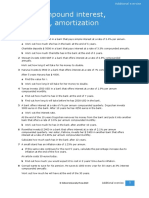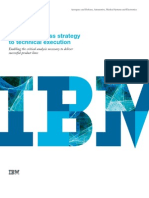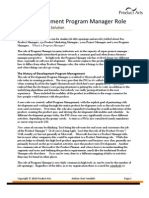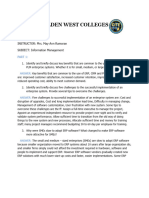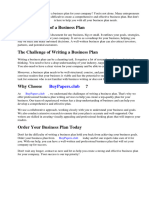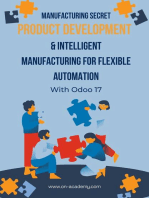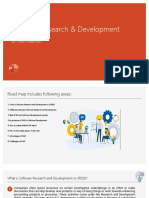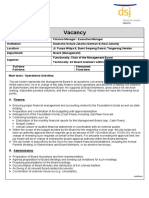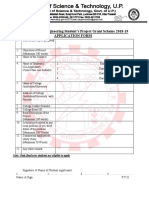!QVM6MA0294C8TopTenRisks
!QVM6MA0294C8TopTenRisks
Uploaded by
sugarholaCopyright:
Available Formats
!QVM6MA0294C8TopTenRisks
!QVM6MA0294C8TopTenRisks
Uploaded by
sugarholaOriginal Title
Copyright
Available Formats
Share this document
Did you find this document useful?
Is this content inappropriate?
Copyright:
Available Formats
!QVM6MA0294C8TopTenRisks
!QVM6MA0294C8TopTenRisks
Uploaded by
sugarholaCopyright:
Available Formats
If you are a registered user of KnowledgeStorm.
com:
This document will open automatically for you.
You can save this document on any computer.
You should save this document before emailing to anyone else.
If you access this document on a different computer, you will need to log in
to view the document.
l
l
l
l
If you are not a registered user of KnowledgeStorm.com:
This document will not be visible until you register at KnowledgeStorm.com.
The registration is free, fast, and painless. l
l
Access to this document has been brought to you by KnowledgeStorm. You are
welcome to distribute this document freely to other colleagues who might find
the content valuable.
Unlock this document
Forgot your password?
Business e-mail address:
Password:
Need to Register?
Unlock this document by providing the business e-mail address and password you
use to access sites in the KnowledgeStorm network.
Note: In order to have an optimal experience, you should view this document using Adobe Acrobat 7.0 or later. Adobe Acrobat 7.0
Questions about this document?
Document Summary
Top Ten Risks to a Configuration Project and How to Avoid Them
by Access Commerce
Published on: November 01, 2005
Type of content: Vendor White Paper
Format: Adobe Acrobat (.pdf)
Length: 18 Pages
Price: Free
Overview:
Implementing new configuration software and processes is similar in several
respects to implementing other information technology (IT) based projects, such
as enterprise resource planning (ERP) or product lifecycle management (PLM)
systems. A few of these similarities include the strategic nature of the project;
its broad scope - encompassing the extended enterprise of customers and
suppliers; the extensive cultural implications; and the necessity for formal
change management methods.
Nevertheless, in developing a feasible plan to implement configuration software
and processes, there are some significant differences to consider. For instance,
ERP / PLM product definition capabilities are limited in their flexibility to create
highly configurable product representations for use by customers to create
unique products. This is because those systems focus on engineering and
manufacturing versions of product structures. Typically, their current product
structuring methods are grossly inadequate to meet sales and marketing
requirements for unique and accurate configurations - developed in a timely and
cost effective manner.
By creatively using configurator software, project teams now will have the
capabilities and flexibility to define product options and variations in any way
deemed necessary - for an effective customer-facing Lead-to-Order (LTO)
process. (3) The implication is clear: To become more customer oriented by
offering highly configurable products, a company will need to dramatically shift
its perspective on how its products are defined and presented to the
marketplace.
As with most IT-based system projects, to gain the considerable rewards may
invite numerous risks. Thus, it takes prudent management to recognize these
risks and to develop viable actions to avoid or to mitigate them - by learning
from and taking advantage of the successful experience of others.
Purpose of this Executive Guide
Overview Continued:
The purpose of this Executive Guide is to help companies gain the intended
benefits from implementing a configurability strategy, by:
- Identifying the top ten risks to a successful product configuration
implementation project, and
- Describing numerous, proven actions to avoid or to mitigate them.
Although this guide presents the indispensable actions to avoid these risks in a
general sequence, a different sequence and/or emphasis may be appropriate for
any individual company situation.
Top Ten Risks to a Configuration Project
and How to Avoid Them
Execut i ve Gui de
Making
Complex
Selling
Simple
This document is locked.
You may unlock this document by returning to the first page.
Contents
Preface. . . . . . . . . . . . . . . . . . . . . . . . . . . . . . . . . . . . . . . . . . 1
Introduction . . . . . . . . . . . . . . . . . . . . . . . . . . . . . . . . . . . . . . 2
Starting on the Right Track . . . . . . . . . . . . . . . . . . . . . . . . . . 3
Developing Effective Configurable Product Models. . . . . . . . 6
Staying on the Right Track . . . . . . . . . . . . . . . . . . . . . . . . . . 12
Conclusion . . . . . . . . . . . . . . . . . . . . . . . . . . . . . . . . . . . . . 14
The Author . . . . . . . . . . . . . . . . . . . . . . . . . . . . . . . . . . . . . . 14
Notes and References . . . . . . . . . . . . . . . . . . . . . . . . . . . . . 14
About Access Commerce . . . . . . . . . . . . . . . . . . . . . . . . . . 15
Top Ten Risks
Copyright 2005 - Access Commerce - All rights reserved.
This document is locked.
You may unlock this document by returning to the first page.
Preface
Companies producing and selling complex and configured products can achieve a
major competitive edge by successfully implementing product configurator software
as the core element of a configurability strategy - "to provide more product
variations using less resources." (1)
Some companies, unfortunately, have painfully experienced the risks of
implementing new software and processes, though eventually gaining benefits.
Other companies may be overly cautious. They can be hesitant to undertake
"another new initiative," even when it is essential to compete in today's demanding
environment.
The promised benefits from implementing product configuration software are many
and may seem too good to be true. However, companies that have successfully
implemented a configuration project confirm its many rewards. Surveys by industry
research firms further validate these claims. (2)
Purpose of this Executive Guide
The purpose of this Executive Guide is to help companies gain the intended benefits
from implementing a configurability strategy, by:
Identifying the top ten risks to a successful product configuration
implementation project, and
Describing numerous, proven actions to avoid or to mitigate them.
Although this guide presents the indispensable actions to avoid these risks in a
general sequence, a different sequence and/or emphasis may be appropriate for
any individual company situation.
1
Top Ten Risks
Copyright 2005 - Access Commerce - All rights reserved.
This document is locked.
You may unlock this document by returning to the first page.
Introduction
Implementing new configuration software and processes is similar in several
respects to implementing other information technology (IT) based projects, such as
enterprise resource planning (ERP) or product lifecycle management (PLM) systems.
A few of these similarities include the strategic nature of the project; its broad
scope - encompassing the extended enterprise of customers and suppliers; the
extensive cultural implications; and the necessity for formal change management
methods.
Nevertheless, in developing a feasible plan to implement configuration software and
processes, there are some significant differences to consider. For instance,
ERP / PLM product definition capabilities are limited in their flexibility to create highly
configurable product representations for use by customers to create unique
products. This is because those systems focus on engineering and manufacturing
versions of product structures. Typically, their current product structuring methods
are grossly inadequate to meet sales and marketing requirements for unique and
accurate configurations - developed in a timely and cost effective manner.
By creatively using configurator software, project teams now will have the
capabilities and flexibility to define product options and variations in any way
deemed necessary - for an effective customer-facing Lead-to-Order (LTO)
process. (3) The implication is clear: To become more customer oriented by offering
highly configurable products, a company will need to dramatically shift its
perspective on how its products are defined and presented to the marketplace.
As with most IT-based system projects, to gain the considerable rewards may invite
numerous risks. Thus, it takes prudent management to recognize these risks and to
develop viable actions to avoid or to mitigate them - by learning from and taking
advantage of the successful experience of others.
2
Top Ten Risks
Copyright 2005 - Access Commerce - All rights reserved.
This document is locked.
You may unlock this document by returning to the first page.
Starting on the Right Track
Risk Number 1: Not Managing the Implementation as a
Strategic Project
If the company does not address this risk directly in the first stages, the result could
be complete project failure - after spending the implementation budget fruitlessly.
Wide industry experience has clearly demonstrated that the most common cause of
this risk is because the organization does not fully understand the strategic nature
and value of the proposed configuration project.
Strategic, in this sense, means a project at the highest level of planning and
execution, fully endorsed and supported by top management to catalyze major
improvements in the company's competitive posture.
Develop a solid business case with a Return on
Investment (ROI) analysis to gain management's
initial commitment; sustain it by quickly showing
results and keeping management informed of
ongoing progress and challenges.
A complete ROI analysis has proven essential to gain management commitment. It
should identify tangible objectives and benefits, one-time implementation costs and
all ongoing costs of IT support.
First, as planning assumptions for developing the benefits side of the ROI equation,
the company's strategic vision may need to be defined or clarified; for instance, will
the company:
Target new market sectors?
Initiate new sales channels and processes?
Some project teams might contend that intangible benefits alone offer sufficient
justification to undertake a configuration project. For management, with an ROI
focus, intangible benefits lack the power to sustain commitment over an extended
period. For the users, however, the soft benefits can be a powerful motivator; for
example, engineers may be very frustrated with the time consuming problems of
developing one-time bills of material (BOMs) that dilute valuable engineering time for
innovative product development. (2)
Once the project team gains management commitment, the attitude might be "thank
heavens, we have management's support, now let's get on with the real job."
Nurturing and retaining management commitment is a real job and will be a
continuing challenge. It must be a top priority of the project team to accomplish this
by using formal project management techniques. These include: consistent status
reporting, means to identify and resolve outstanding project issues, and a
comprehensive communications approach. Project management software can only
provide a partial solution.
3
Top Ten Risks
Copyright 2005 - Access Commerce - All rights reserved.
The Spectrum of
ToOrder Products
Pick-to-Order (PTO) -
productsusually shipped from
stock inventory, for example,
catalog items with optional
accessories shipped with the
catalog item.
Assemble-to-Order (ATO) -
products with standard sets of
predefined features and options,
from which unique product
configurations are developed by
the customer selecting specific
features and options, for example,
computers ordered over the
Internet.
Configure-to-Order (CTO) -
products based on consultative
dialogue with the customer,
through Web interface, to address
specific requirements. The
products have been predesigned
in computer-aided-design (CAD)
models or parameterized
documents, but not predefined
with specific part numbers, for
example, products with
dimensional and spatial
requirements, such as hydraulic
actuators, and windows and
doors.
Engineer-to-Order (ETO) the
most complex products that
during configuring must interface
with product development
activities and tools, such as CAD
software, design rules and other
expert IT systems that can
support development of
configuration, pricing, and
complete documentation over a
typically iterative proposal cycle;
for example, electrical distribution
systems.
Action
This document is locked.
You may unlock this document by returning to the first page.
In addition, the project team must seriously consider the value of an early success,
such as a "rapid prototype," to sustain enthusiasm for achieving the project's
intended benefits. In a similar vein, another viable approach is the tactic of "self-
funding" later stages of an implementation through the benefits gained from its initial
successes.
Risk Number 2: Not Having the "Right" People on the
Project
Without the "right" people on the project team, two major risks will almost certainly
appear:
The configurable product model will not meet the requirements of all
organizational functions, including customers and suppliers
The eventual users may not fully accept the newly developed configurable
product models and the supporting processes
The critical question is, therefore, who are the "right" people?
Recognize the required makeup of the project
team: multi-disciplined with in-depth product
knowledgeable people - and led by the business
and not by IT personnel.
"Right" is . . . those product experts that are integral to the current day-to-day
operations and who supposedly "cannot be spared." These people have the
expertise and perspective to design product models that meet the needs of the
enterprise. Clearly, providing personnel who "cannot be spared" depends on the
strength of management's commitment to the configuration project.
Furthermore, project leadership should be in the hands of those responsible for the
future, on-going operation of the system - the sales, marketing and/or engineering
personnel.
To bring together and forge an effective project team, the qualifications and
capabilities of the "right" prospective team members must be evaluated:
Will they be willing participants?
Will they be able to stay motivated in the face of occasional setbacks during
the progress of the project?
Will they resist being distracted by their "real" jobs?
Can they function effectively at two different thought levels: conceptual and
the detail of product modeling?
Can they make decisions to facilitate conflict resolution?
4
Top Ten Risks
Copyright 2005 - Access Commerce - All rights reserved.
Action
This document is locked.
You may unlock this document by returning to the first page.
Define the "right" tasks for the "right" people
to accomplish the project's objectives.
The project team's prime responsibilities are to develop a feasible project budget
and schedule, paying special attention to the product modeling effort; and to design,
test and implement configurable product models and related processes that meet
the company's strategic vision. Moreover, acting as proactive change agents and
maintaining open, two-way communications with the rest of the organization are
particularly important with respect to the cultural risks, described next.
Risk Number 3: Not Fully Understanding the Cultural Issues
Experienced companies frequently refer to cultural risks as one of the foremost
reasons for project failures. Technical reasons have rarely been the cause.
The risks here are often subtle; like an iceberg. The obvious, formal policies and
processes exist above the waterline. Beneath it may be the informal - attitudes,
values, norms and fears - that endanger the project. For example, a company may
have relied on a certain department and/or individual to know the subtleties of
generating a customer's unique product configuration. Thus, these users may
perceive a change in roles and responsibilities - using the new configurability
processes - as a loss of status and power.
Clearly identify the cultural issues that might
endanger the project.
A fundamental truism here is that management commitment, by itself, does not
solve cultural resistance to accepting new processes. Accordingly, the project team
cannot be passive, hoping that time will cure the resistance risks, or that momentum
will sweep along any dissenters. It will take a proactive approach by the project
team to gain user acceptance of new processes and responsibilities.
In fact, the project team must relentlessly work to eliminate any potential
organizational potholes and landmines that can undermine expected project
benefits. Additional actions:
Maintain constant contact with all affected users through both formal
communication means and informal methods
Conduct orientation and educational sessions, perhaps some conducted by
outsiders who can bring fresh perspective to the effort
Hire a change management consultant versed and experienced in cultural
issues and how to resolve them
Accept constructive conflict as a healthy situation and destructive conflict as
unacceptable
5
Top Ten Risks
Copyright 2005 - Access Commerce - All rights reserved.
Action
Action
This document is locked.
You may unlock this document by returning to the first page.
Developing Effective Configurable Product Models
Risk Number 4: Not Completing a Valid Product Model and
Process Design
An attitude of "let's get on with the solution, we all know the problems" can lead to
undesirable risks in the early phases of the project. It is a natural posture: some
project teams may be too eager to start playing with the new software before they
initiate a purposeful design process. This is a dangerous attitude that could lead to
false starts and costly project course corrections.
If the project team does not have a clear focus on project objectives, other risks can
surface during the remaining phases of the project:
Incomplete model and process design
Rework of processes required later in the project
Heavy reliance on peoples memory and tribal knowledge
Personnel turnover
Politics gain the upper hand resulting in individual or functional needs
becoming more important than the overall enterprise needs
Identify the strengths and weaknesses of the
Current State methods and processes related to
the configurability strategy; then develop the
desired Future State. (4)
Current State review
Selectivity is essential - too much documented detail is not necessary. The Current
State of product variability, such as available options and combinations, however,
does deserve a high degree of attention and detail. Understanding the current
demographics will help to accurately estimate and to facilitate the product modeling
effort, for instance, the number of features, the logic controlling the relationships,
and the interoperability of options. Structured design methodologies that use visual
aids are useful here. Moreover, the project team should recognize informal sources
of product information, for example, Post-it notes and tribal knowledge.
Additionally, the company must avoid the myth of "We have to make our current
systems work first." Time is too valuable to waste trying to improve poor systems on
a piecemeal basis. Companies can avoid this risk by developing and following the
strategic direction provided by a Future State design.
6
Top Ten Risks
Copyright 2005 - Access Commerce - All rights reserved.
Action
This document is locked.
You may unlock this document by returning to the first page.
Future State design
The goal of this action is to create a comprehensive design for product models and
processes. To accomplish this:
Identify the metrics of configurability success, for instance, the accuracy of
configured quotes and orders
Define the affected processes at a general objectives and policies level only;
procedural detail can come later
Clarify planning assumptions that influence or constrain the design to avoid
the painful hindsight, "Oh, but I thought . . ."
Make use of a comprehensive design methodology to avoid missteps
Draw on best practice checklists as prompters
Recognize factors that should be resolved before a configurator can be fully
used, for example, an effective product change management process
Share the evolving design continuously with management and users and
solicit feedback before final approval
This last noted action is one of the best-known tactics to determine if the design is
complete - not stopping short at the 80% completion state.
The overall design of the Future State processes and the user experience with them
must be intuitive and perceived as a natural part of their interaction, not an added
burden to be endured. In addition, there are critical considerations in developing
valid product families and models, described in the next section.
Risk Number 5: Not Attaining the "Right" Perspective when
Designing Product Families and Models
One of the key tasks awaiting the project team is to develop a fresh perspective on
the definition of product families and models by taking advantage of the capabilities
in the configurator software. Gaining perspective means to abstract or visualize new
groupings of product families and models to achieve more effective configuring of
complex, unique products. Often, though, Current State engineering and
manufacturing product structures do not lend themselves to accurate and timely
configuring of products in a revitalized LTO process.
Failing to address the concepts of the "right" perspective may result in unusable
configurable product models and these undesirable consequences - at two levels:
1. Operational unduly complex, time consuming and costly on-going model
revision and maintenance, and
2. Strategic eroding the customers confidence, and even losing business, if the
customers view the new product configuration and LTO process as unwieldy
7
Top Ten Risks
Copyright 2005 - Access Commerce - All rights reserved.
This document is locked.
You may unlock this document by returning to the first page.
Unfortunately, there is no "magic bullet" to absolutely avoid the risks - do not waste
time searching for it. At best, the company must strive to mitigate them during the
tasks, described next.
Plan and carry out a comprehensive design
process and conduct periodic reviews with users
and top management - so that the results
conform to the company's strategic vision.
The goal is to achieve the "right" perspective in new product family definition - by
balancing conflicting factors, including the usability of configurable product models
versus flexibility and the cost of family and model maintenance. This goal also
means that the following organizational functions must be wholehearted participants
in the decision process: marketing and sales - to ensure usability of the configurable
product models by customers in a revised LTO process; engineering - to signify
what can be produced; and manufacturing - to indicate what is optimal to produce.
Typically, a project team will carry out a whole series of interrelated tasks to reach
the goal of the "right" perspective. In a general sequence:
1. Understand the strategic vision regarding target markets and customer
characteristics. Developing answers to some questions may catalyze a fresh
definition of product families. Among them:
What sector of the "To-Order" spectrum will the company tackle?
To what degree are customers sophisticated and knowledgeable about what
they need in a customized product?
What will be most effective for customers using the configurator software:
feature/option selection? - a needs analysis approach? - or combinations of
both? - in a guided selling mode?
What are the customers delivery expectations?
2. Define and decide on the important factors in product family and model
development, considering the customer level of product knowledge/expertise,
product complexity and anticipated levels of maintenance; then set priorities and
balance the trade-off decisions.
3. Visualize and evaluate the possible new or revised product family groupings. The
two extremes in product family definitions too few high-level product families or
too many product families will both result in unnecessary maintenance time and
cost.
8
Top Ten Risks
Copyright 2005 - Access Commerce - All rights reserved.
Action
This document is locked.
You may unlock this document by returning to the first page.
4. Do not let product configuration exceptions rule. This can distort the design effort
and be time consuming.
5. Recognize that there will be an inflection point (where the value is still increasing,
but at a reduced rate); for example, increasing flexibility in future model maintenance
is a desirable capability. On the other hand, too much flexibility will complicate
maintenance.
6. Review the evolving perspectives and recommended choices of proposed new
product families with users and top management to gain approval before expending
additional design effort and incurring costs.
7. Create new product families; prototype one or two to test for customer usability
and maintenance considerations.
The project team must accept the reality that attaining the "right" level of
perspective for new product families and configuration processes is not a once
through process; expect some iteration of some or all of the above actions.
Certainly, anticipate some rousing debates during this phase.
Risk Number 6: Mis-estimating the Modeling Workload
Product modeling will be a major part of the project budget and schedule. When
developing the project plan, there are two undesirable possibilities to be avoided:
underestimating or overestimating the modeling effort. Either can trigger common
risks - detrimental to project success:
Diluting management commitment due to loss of confidence in the project
team
Deteriorating team members commitment to the modeling effort
Transferring team members - who cannot be spared - off the project
Losing project momentum
Underestimating the product modeling effort and subsequently requesting additional
budget and time from the executive steering committee will directly lead to the
aforementioned risks. Be aware of potential root causes, such as not understanding
the process, or the presence of highly motivated, but overly optimistic, team
members.
Overestimating the product modeling effort also has additional downside.
Management and users may react negatively to initial schedules that are perceived
to take too much time before showing results. Here, root causes may include a lack
of understanding, or poorly motivated, overly pessimistic team members who might
be inclined to "pad" estimates for protection.
Understand and evaluate the product complexity
factors and the effort required to develop
product models - on time and within budget
limits.
9
Top Ten Risks
Copyright 2005 - Access Commerce - All rights reserved.
Action
This document is locked.
You may unlock this document by returning to the first page.
Because only the project team - no others - will be accountable for the accuracy of
the product modeling estimates, it is imperative they have the requisite
understanding of product modeling before they commit to a schedule. There is no
magic Excel spreadsheet to develop the estimates. Thus, it will be a highly
judgmental exercise demanding a high degree of attention to both product
complexity and team member capabilities.
Product Factors
In the Current State review phase, the project team will have identified a number of
product variability factors. These are statistical and qualitative descriptors defining
the complexity of the products - that are needed to develop an accurate modeling
estimate.
A company's products may span the range of Assemble-to-Order (ATO), Configure-
to-Order (CTO) and Engineering- to-Order (ETO). As a rule, the more complex the
product, e.g., CTO and ETO, the greater the product modeling effort. Therefore, the
following factors need to be carefully evaluated:
Where do the products fall in the range of ATO, CTO and ETO?
Number of product families?
Number of characteristics per product family as engines in automobile
models?
Number of possible choices for each characteristic as engine horsepower
selections?
Number of parts needed to make a unique product configuration?
What configuration relationships currently exist that will need to be accounted
for in the new product models: complex pricing strategies, sub- level
configurable BOMs, integration with CAD software, and rules for dimensional
and parametric calculations?
People Factors
At this time, a key question is . . . do the project team members have the requisite
understanding of the product modeling effort to develop accurate estimates?
Greater understanding of the future modeling effort should result from collaborating
with the software vendor - with their experience - to leverage the project team's
knowledge of the product. One distinct possibility is to co-develop a prototype
product model with the software vendor. This approach also provides active
software-specific training. However, the project team must retain the eventual, on-
going modeling responsibilities that should not be defaulted to the software vendor.
Now is also a good time to maintain active dialogue with experienced configurator
implementers - in complex product companies with similar characteristics - to gain
a better understanding of the scope and intensity of the product modeling effort.
10
Top Ten Risks
Copyright 2005 - Access Commerce - All rights reserved.
This document is locked.
You may unlock this document by returning to the first page.
Furthermore, it may be necessary to initiate appropriate actions to improve the
project team's effectiveness, by reconfirming the project objectives and rationale;
regenerating motivation with fresh management direction; and reaffirming roles and
responsibilities, such as the power to make decisions to resolve conflicts.
Risk Number 7: Not Selecting the Appropriate Product
Family to Start Product Modeling
Most companies will have a choice of which product family to select for the initial
product modeling effort. There are often two extremes to evaluate, simple or
complex - each with attendant risks. Starting with a complex family that promises
greater benefits may be tempting, because of the desire to gain the greatest
immediate benefits with improved product configurability. Nevertheless, starting with
a too complex product line may prove self-defeating. The project team may not
have the experience level required for a successful outcome. An unfavorable,
demoralizing result could cause a loss of confidence.
There is an advantage to consider in starting with a simple product line: it shows
results quickly. Conversely, the project team may not gain the requisite experience
to later tackle the more difficult product lines.
Consequently, neither extreme - too complex or too simple - is an appropriate tactic.
Select the appropriate product family to model.
Designating the appropriate product family to start the modeling effort is properly a
top management decision. Accordingly, the project team must identify the selection
criteria before choosing and submitting a recommendation to the steering
committee. Not all decision criteria will be compatible, thus, forcing an intelligent
choice after considering:
The substantial business impact, such as potential to increase market share,
that will help to gain and sustain organizational momentum
The degree of product complexity and the learning experience to be gained
for the remaining modeling efforts
The readiness of the users
A prudent approach is to choose the first product family to model that gains
significant business impact, yet is not too complex. Moreover, all users outside the
project team should be able to fully understand the evolving configuration model.
In addition, continuing success would maintain the confidence of the management
steering committee, as well as the eventual users.
11
Top Ten Risks
Copyright 2005 - Access Commerce - All rights reserved.
Action
This document is locked.
You may unlock this document by returning to the first page.
Risk Number 8: Inadequate Testing of the Configurable
Product Model
One of the worst possible risks is to have customers find errors in the product
models as the models "go live." One cause of this risk could be lack of valid input
from knowledgeable personnel during earlier phases of the project, resulting in an
inadequate configurable product model. Superficial model testing may not identify
faulty configurable logic.
Preempt the risk with a comprehensive testing
plan comprised of these elements:
Develop comprehensive validation methods, based on structured input, to test
all possible combinations of configuration logic and error messages
Start testing early and do it often dont wait until the model is complete
Establish acceptance (buyoff) criteria, for instance, the ability to handle all
structured input created to test the model logic, to produce error messages,
and to develop an accurate configuration
Bring in prospective users from outside the project team to assist in early and
continuous testing, such as those from sales, channel partners and selected
customers
Recheck the adequacy of product modeling training
Avoiding the risks of inadequate testing exemplifies the integral relationship with
previously identified actions, particularly assigning the "right" people to the project
team.
Staying on the Right Track
Risk Number 9: Not Adequately Defining New Processes for
Maintaining and Publishing of Models
In complex product companies facing blistering competition, constant change is
expected, usually at lightning speed, driven by customer demands. Without
adequate processes for updating product models in a timely and efficient manner, a
number of risks can surface:
At an operational level - increasing maintenance costs and extended time to
implement new models leads to the highest level of risk, that is . . .
At the strategic level - losing market opportunities, revenue and even
customers. . . perhaps the most painful of all risks
An underlying cause of this risk might be that the project team mistakenly views the
next actions as those to tackle just before "going live" with the new product models.
Worse yet is that the project team did not exercise the discipline to take the
following actions in earlier planning phases.
12
Top Ten Risks
Copyright 2005 - Access Commerce - All rights reserved.
Action
This document is locked.
You may unlock this document by returning to the first page.
Identify, define and test all processes associated
with the timely revision of the product models
well before "going live."
In configuration management terms, the goal is to ensure the revision integrity of the
product models. A recognized best practice is to conduct a continuous and
comprehensive conference room pilot using the evolving product models to
generate these mandatory outcomes:
Identify all rules for change management of the product models
Validate all interfaces to related systems, such as ERP and PLM
Define/clarify all policies and responsibilities for the ongoing operation of the
new processes
Accomplish any final education and training requirements before the next
activity
Risk Number 10: Not Planning for User Acceptance of the
New Product Configuration Processes
Waiting until late in the implementation cycle to plan user acceptance will only
exacerbate the risks, already cited above. Scrambling at the last minute in reaction
to user sensitive problems may trigger even more resistance: fear of excessive work
pressure and loss of control at the time of "going live." The possible rewards of the
new processes may no longer appear adequate or satisfying.
Work proactively to develop a user acceptance
plan.
The approach to avoid this risk starts at the time of gaining management
commitment. While stated in this risk category, the project team must accomplish
most of the following actions throughout earlier phases of the project:
Establish an active communications methodology beginning as soon as
management has authorized the project
Create a sense of "ownership" of the configurable product models and the
related new processes
Provide a feedback mechanism to the project team for additional
improvements
Incorporate a mix of motivational methods, both positive (carrot), and as
necessary, negative (stick)
Essentially, the project team needs to execute a marketing strategy for creating
enthusiastic user acceptance, not foot dragging resistance.
13
Top Ten Risks
Copyright 2005 - Access Commerce - All rights reserved.
Action
Action
This document is locked.
You may unlock this document by returning to the first page.
Conclusion
For complex product companies immersed in the "To-Order" market, a configuration
project is not an option - it is an absolute necessity to survive and thrive.
Forward thinking companies do not tolerate excuses for inaction, as . . . "Oh, but we
are not ready." This is because in today's environment of blistering competition,
doing nothing is one of the greatest risks of all.
Take purposeful, preemptive actions to avoid the potential risks to a configuration
project - by catalyzing the next steps: review . . rate . . and tailor the actions
outlined in this guide. Then, aggressively pursue them by closing any gaps between
the company's current reality and the actions needed to be successful. This will help
to ensure the maximum rewards from a configuration project - leading to major
competitive advantages.
The Author
Richard W. Bourke is a principal consultant with extensive experience in systems
planning and implementation. His clients have ranged from Fortune 100 companies
to small manufacturing firms. For other publications, visit
www.bourkeconsulting.com.
Contributing Author
Andrew Tubbs is the Vice President, Professional Services for Access Commerce in
North America. He has more than 13 years experience implementing product
configuration software solutions and has led more than 100 successful projects,
including deployment of the first web-based configurator for the world's largest
automotive OEM.
Notes and References
1. Access Commerce, "Configurability: A Competitive Advantage," 2005.
www.access-commerce.com.
2. AMR Research, "Configuration is the Heart of Customer Fulfillment for Complex
Product Manufacturers," 2003.
3. Access Commerce, "Optimizing the Lead-to-Order Process," 2004.
4. The Lean community differentiates the two conditions of processes as Current
State (sometimes known as "As-Is") and Future State ("To-Be").
5. Access Commerce, Cameleon Model Designer methodology, 2000-2005.
14
Top Ten Risks
Copyright 2005 - Access Commerce - All rights reserved.
This document is locked.
You may unlock this document by returning to the first page.
About Access Commerce
Access Commerce is the developer of Cameleon Advanced Selling and Product
Configuration Solutions. Cameleon optimizes core selling activities by intelligently
automating key business functions across sales channels: lead management,
guided selling, product configuration, pricing optimization, quote and proposal
generation, order management and manufacturing data generation.
Access Commerce was founded in 1987 in Toulouse, France and today has more
than 250 customers in 15 countries. The company is listed on the Euronext Stock
Exchange (Euronext: 7424).
For further information, email to info@access-commerce.com or contact us at:
North American Headquarters
1419 Lake Cook Road
Deerfield, Illinois 60015
(847) 236-9061
European Headquarters
Rue Galile BP 87270
31672 LABEGE Cedex France
+33 5 61 39 78 78
www.access-commerce.com
15
Top Ten Risks
Copyright 2005 - Access Commerce - All rights reserved.
This document is locked.
You may unlock this document by returning to the first page.
www.accesscommerce.com
This document is locked.
You may unlock this document by returning to the first page.
You might also like
- Frank Ochoa - Secrets of Pivot Boss 1Document196 pagesFrank Ochoa - Secrets of Pivot Boss 1Zorif Demha100% (8)
- Extra Worksheet - Annuties, Compund and AmortizationDocument3 pagesExtra Worksheet - Annuties, Compund and AmortizationAaryan Kulkarni100% (1)
- Digital Marketing Plan Strategy Workbook Smart InsightsDocument71 pagesDigital Marketing Plan Strategy Workbook Smart InsightsJose Luis Fernandez100% (3)
- Business Analyst Interview Questions and AnswersDocument17 pagesBusiness Analyst Interview Questions and AnswersRobin100% (10)
- Gerber PLM White PaperDocument13 pagesGerber PLM White PaperPartibanKumarNo ratings yet
- Software Product Development Business PlanDocument5 pagesSoftware Product Development Business Planafwnsfdcnyyfka100% (1)
- Raw 14232 Us enDocument8 pagesRaw 14232 Us enAlexandre GreberNo ratings yet
- Business Continuity Plan Internal AuditDocument7 pagesBusiness Continuity Plan Internal Auditpalapujikyp3100% (1)
- ch15 Accounting Systems Solution ManualDocument10 pagesch15 Accounting Systems Solution ManualLindsey Clair Royal100% (1)
- 15.30 - Mario SanvitaleDocument23 pages15.30 - Mario SanvitaleNachiketa GuptaNo ratings yet
- Business Continuity Plan Audit ObjectivesDocument7 pagesBusiness Continuity Plan Audit Objectivesqjp374b2100% (1)
- Solution: Objectives & BenefitsDocument89 pagesSolution: Objectives & BenefitsskrishatguruNo ratings yet
- 7 Characteristics of A Winning Product StrategyDocument6 pages7 Characteristics of A Winning Product StrategyJindatip Sherry SirikunakornNo ratings yet
- Shell Business Continuity PlanDocument7 pagesShell Business Continuity Planafwnqobdqpgqys100% (1)
- Digital Strategy Toolkit Workbook Smart InsightsDocument56 pagesDigital Strategy Toolkit Workbook Smart InsightsMichelle Ngan Dao100% (2)
- Ibm Business Continuity Plan TemplateDocument7 pagesIbm Business Continuity Plan Templaterhhvnrbie100% (1)
- Starsmart - A Framework For Distributed Outsourced Product DevelopmentDocument8 pagesStarsmart - A Framework For Distributed Outsourced Product DevelopmentSomenath NagNo ratings yet
- Research Paper On Software Risk ManagementDocument6 pagesResearch Paper On Software Risk Managementqbqkporhf100% (1)
- The Development Program Manager RoleDocument4 pagesThe Development Program Manager RoleRaviram NaiduNo ratings yet
- Business Case and Project Management PlanDocument4 pagesBusiness Case and Project Management Planafmbwobeh100% (1)
- Solution Framework Development: Using The Solution FrameworksDocument16 pagesSolution Framework Development: Using The Solution FrameworkshimsupNo ratings yet
- Project ReportDocument50 pagesProject ReportSankalp KhatriNo ratings yet
- Business Plan Production ProcessDocument6 pagesBusiness Plan Production ProcessafwnsfdcnyyfkaNo ratings yet
- Roll Out ApproachDocument10 pagesRoll Out ApproachSeetharaman Ramachandran100% (2)
- Environmental Analysis Business Plan ExampleDocument4 pagesEnvironmental Analysis Business Plan Examplejxqcfyozg100% (1)
- BA Interview Questions and Answers 1698202392Document29 pagesBA Interview Questions and Answers 1698202392Shailendrahasabe@gmail.com100% (1)
- Software Implementation PlanDocument10 pagesSoftware Implementation PlanricharkintuNo ratings yet
- EpicDocument11 pagesEpicWesleyNo ratings yet
- Finals (Information Management)Document8 pagesFinals (Information Management)subidomaryjoy3025No ratings yet
- Preparation Bussines PlanDocument39 pagesPreparation Bussines PlanEnis ByciNo ratings yet
- Data Warehouses: FPT University Hanoi 2010Document39 pagesData Warehouses: FPT University Hanoi 2010ngọc bìnhNo ratings yet
- Continuous: How To Map The Value Stream For A Service Organization?. Available FromDocument4 pagesContinuous: How To Map The Value Stream For A Service Organization?. Available FromFadzil Adly IshakNo ratings yet
- PLM White Paper Kalypso Top 10 Transformational Objectives PDFDocument2 pagesPLM White Paper Kalypso Top 10 Transformational Objectives PDFshrinivas gNo ratings yet
- Business Plan Deployment BoardDocument4 pagesBusiness Plan Deployment Boardexllctqvf100% (1)
- Manufacturing Business Continuity Plan TemplateDocument8 pagesManufacturing Business Continuity Plan TemplateyayeqzqsfNo ratings yet
- Business in Digital ErrorDocument18 pagesBusiness in Digital ErrorPiyush ShuklaNo ratings yet
- Difference Between Project Report and Business PlanDocument5 pagesDifference Between Project Report and Business Planqjp374b2100% (1)
- Business Continuity Plan LogoDocument7 pagesBusiness Continuity Plan Logoyayeqzqsf100% (1)
- "Milestone Deliverables" A Guide To Managing IT Implementation ProjectsDocument8 pages"Milestone Deliverables" A Guide To Managing IT Implementation ProjectsChuks Anakudo0% (1)
- Manufacturing Secret : Product Development and Intelligent Manufacturing For Flexible Automation With Odoo 17: odoo consultations, #1.1From EverandManufacturing Secret : Product Development and Intelligent Manufacturing For Flexible Automation With Odoo 17: odoo consultations, #1.1No ratings yet
- APR Effective-Cost-Mgmt-WP FNL4 WEB PDFDocument20 pagesAPR Effective-Cost-Mgmt-WP FNL4 WEB PDFSuresh YadlaNo ratings yet
- 2019 Six - Practices - For - Effective - Portfolio - MGMT - 385064Document13 pages2019 Six - Practices - For - Effective - Portfolio - MGMT - 385064LauraNo ratings yet
- Product Roadmap White PaperDocument8 pagesProduct Roadmap White PaperRuchika SinghNo ratings yet
- Product Management Plan Format As Semestral Output 2020Document10 pagesProduct Management Plan Format As Semestral Output 2020Lorie GeneNo ratings yet
- Elastic Path Ecommerce ProjectsDocument8 pagesElastic Path Ecommerce ProjectsSohan ChoudhuriNo ratings yet
- Business Dashboards: A Visual Catalog for Design and DeploymentFrom EverandBusiness Dashboards: A Visual Catalog for Design and DeploymentRating: 4 out of 5 stars4/5 (1)
- Assignment PM 01Document15 pagesAssignment PM 01Pawani HettiarachchiNo ratings yet
- Product Development ProcessDocument36 pagesProduct Development ProcessShariq SharifNo ratings yet
- Software Development Life Cycle - A Complete GuideDocument9 pagesSoftware Development Life Cycle - A Complete GuideAleksandra VelickovicNo ratings yet
- Cost Reduction ThesisDocument7 pagesCost Reduction ThesisCanSomeoneWriteMyPaperForMeSaltLakeCity100% (2)
- Software Research & DevelopmentDocument17 pagesSoftware Research & DevelopmentSadaf Maqsood QaziNo ratings yet
- PLM Module 1 NotesDocument17 pagesPLM Module 1 NotesChirag NaikNo ratings yet
- PDD LectureDocument25 pagesPDD LectureNandani SinghNo ratings yet
- Business Intelligence Project Plan SampleDocument5 pagesBusiness Intelligence Project Plan Samplepalapujikyp3100% (1)
- Pratical No 14 Edp HKKDocument5 pagesPratical No 14 Edp HKKHKK 169No ratings yet
- Computer Security Consulting Business PlanDocument5 pagesComputer Security Consulting Business Planqjp374b2100% (1)
- Enterprise Level Tools For Innovations, Business PlanDocument42 pagesEnterprise Level Tools For Innovations, Business PlanSavya JaiswalNo ratings yet
- Ict Business Continuity Plan TemplateDocument9 pagesIct Business Continuity Plan Templateafwnsfdcnyyfka50% (2)
- Manufacturing Management ThesisDocument6 pagesManufacturing Management Thesisbnjkstgig100% (2)
- Thesis About Business Process ImprovementDocument8 pagesThesis About Business Process ImprovementRichard Hogue100% (2)
- Cost Estimation in Agile Software Development: Utilizing Functional Size Measurement MethodsFrom EverandCost Estimation in Agile Software Development: Utilizing Functional Size Measurement MethodsNo ratings yet
- New Product Development Essentials: Hands-on Help for Small Manufacturers and Smart Technical People: No Nonsence Manuals, #2From EverandNew Product Development Essentials: Hands-on Help for Small Manufacturers and Smart Technical People: No Nonsence Manuals, #2Rating: 4 out of 5 stars4/5 (1)
- CALA Homes Appeal LetterDocument2 pagesCALA Homes Appeal LetterMark Watts-JonesNo ratings yet
- Basic Macroeconomics Module Part 2Document206 pagesBasic Macroeconomics Module Part 2Ikrima ibn abdisaNo ratings yet
- Group - 01 - Electronics and Electrical Industry - Warchest - Priyanshu JainDocument49 pagesGroup - 01 - Electronics and Electrical Industry - Warchest - Priyanshu JainAman DewanganNo ratings yet
- CMC Regulations 2019Document25 pagesCMC Regulations 2019Hamid RazaNo ratings yet
- Managet Finanec DatDocument2 pagesManaget Finanec DatoktaviaTJNo ratings yet
- Rules and Regulations On Administrative Discipline in The Civil Service and UpdatesDocument129 pagesRules and Regulations On Administrative Discipline in The Civil Service and Updatesibito_on100% (1)
- Tidal EnergyDocument19 pagesTidal Energypatel noorNo ratings yet
- Rajasthan Electricity Duty Act 1962Document6 pagesRajasthan Electricity Duty Act 1962Latest Laws TeamNo ratings yet
- 1992 Issue 4 - Book Reviews: Books by John Gerstner - Counsel of ChalcedonDocument1 page1992 Issue 4 - Book Reviews: Books by John Gerstner - Counsel of ChalcedonChalcedon Presbyterian ChurchNo ratings yet
- Bidding Documents For Contract of Different Canteens in Mayo Hospital, Lahore For The Financial Year 2020-21Document84 pagesBidding Documents For Contract of Different Canteens in Mayo Hospital, Lahore For The Financial Year 2020-21Rana Ahmad AamirNo ratings yet
- CSTUPDocument8 pagesCSTUPsaurabh singhNo ratings yet
- Status Report - Assignment 4 Group 1 - 0IBDocument8 pagesStatus Report - Assignment 4 Group 1 - 0IBhiralhshethNo ratings yet
- Faqs About Udaan AppDocument4 pagesFaqs About Udaan AppPugalmeena PugalmeenaNo ratings yet
- Charity CommitteeDocument2 pagesCharity CommitteejohanmendeleevNo ratings yet
- MN 121 - Cula-Suññata Sutta - The Lesser Discourse On EmptinessDocument7 pagesMN 121 - Cula-Suññata Sutta - The Lesser Discourse On EmptinessMartin SeidenstickerNo ratings yet
- Automobile December 2023Document2 pagesAutomobile December 2023ss1976No ratings yet
- Pelaburan 1986Document4 pagesPelaburan 1986Ken ChiaNo ratings yet
- Indian Medical Association: Family Security SchemeDocument1 pageIndian Medical Association: Family Security SchemeAmol Dhanvij100% (2)
- Planters Product, Inc. vs. CADocument2 pagesPlanters Product, Inc. vs. CAJovelan V. EscañoNo ratings yet
- RR No. 18-2020Document2 pagesRR No. 18-2020Jenel ChuNo ratings yet
- Elie SaabDocument2 pagesElie SaabalexandraNo ratings yet
- What Is Sound Christian Music?Document11 pagesWhat Is Sound Christian Music?Calvary Tengah Bible-Presbyterian ChurchNo ratings yet
- Psychiatry LogbookDocument3 pagesPsychiatry Logbookع كيف كيفك Dhaif-saeedNo ratings yet
- Risk Management GameDocument3 pagesRisk Management GameDhanalakshmi ThiyagarajanNo ratings yet
- International Bus System Benchmarking: Performance Measurement Development, Challenges, and Lessons LearnedDocument15 pagesInternational Bus System Benchmarking: Performance Measurement Development, Challenges, and Lessons Learnedabdallahragab075No ratings yet
- Ritualising in Book Clubs Implications For EvolvingDocument11 pagesRitualising in Book Clubs Implications For EvolvingFlavia CoelhoNo ratings yet
- Spouses Domingo V. Roces G.R. No.147468 April 9, 2003 Doc RineDocument2 pagesSpouses Domingo V. Roces G.R. No.147468 April 9, 2003 Doc RineConsuelo Narag GalagalaNo ratings yet
- Savage Worlds - 50 Fathoms - CompanionDocument73 pagesSavage Worlds - 50 Fathoms - CompanionRalph ThomassenNo ratings yet

